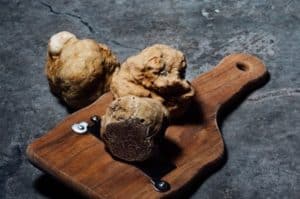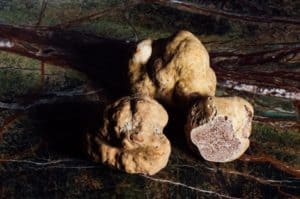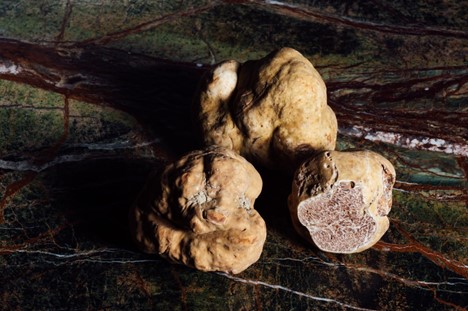Discover Italy’s Famous Alba White Truffle – All You Should Know

The dusk and dawn fog hangs low and thick over Alba’s rolling hills, decongesting the browning backdrop like a retro Instagram filter. From the end of September to January, this town tucked away in the Northwest region of Piedmont hosts tourists who flock to the UNESCO World Heritage site in droves for the transient flavor and aroma of underground goodness; the garlicky and earthy Alba white truffle, also known as Tartufi Bianchi, the prized white truffle.
In this guide, we’ll explore the ins and outs of this prized and elusive fungus. Read on!
What Are White Truffles?
The Tuber Magnatum (Winter White Truffle) is also known as Piedmont or Alba White Truffle because Italy has been blessed with an abundance of these fungi. Harvested from September to January, the short winter season adds mystique that encompasses this fungus.
A truffle tuber usually grows a few inches underground due to their symbiotic relationship with the roots of hardwood trees such as hornbeam, oaks, hazelnut, and chestnut.
The uniquely-structured knobby small spheres vary in size from about an inch and spread across to more than a pound. The sturdy flesh of white truffles is light brown to pale cream with white marbling spread across the cap. These aromatic fungi are located by the keen noses of uniquely-trained canines that can smell them through the earth.
Pigs were conventionally used for foraging for these mushroom species, but that changed when people grew weary of them consuming too many valuable truffles. Female pigs (sows) are instinctively in quest of truffles as they give off a scent that closely mimics porcine pheromones (the reason for their intense ardor).
The appeal behind the Alba white truffle remains a mystery. While expressing the nuances of flavor, these mushrooms can best be described as reminiscent of shallot or garlicky.
Nevertheless, this description doesn’t do justice to the earthy flavor with tones of the nuts from trees whose roots cover the truffles. The Alba white truffle is memorable and pungent, a blend of animal secretion, hints of woodiness, and mineral secretion. White truffles undoubtedly awaken primal instincts in those who consume them as their adherents are passionate and in abundance.
White truffles are the true fruits of the earth, more valuable and a rarity compared to other edible roots, types of mushrooms, or tubers. The boldly unique truffle flavor is probably why they are typically regarded as heavenly.
While there have been various attempts to domesticate these wild truffles, they can take up to 10 years to grow. Granted, some of these attempts have been successful. However, the most reliable source is to learn how to forage for them in the wild as a truffle hunter.
How to Shave the Alba White Truffle
The dirt on the surface of the truffle is best gotten rid of with water coupled with a medium-stiff brush. It’s then shaved using truffle water that you’ll find at your local cooking supply store. Shaving Alba white truffles is the only way to serve them. Unlike wild oyster mushrooms and other species that you can slice into tiny pieces or grind, the thin truffle shavings unveil the bold aroma of the Alba white truffle.
How to Eat Alba White Truffles
These are a delicacy, and their bold aroma doesn’t need to be masked by infusing other flavors into your recipe. The biggest mistake most people know is cooking white truffles. Contrary to black truffles that call for heat to bring out their bold fragrance, Alba white truffles are made of 80%. Therefore, exposure to high temperatures destroys their organoleptic properties.
White truffles are best served on omelets, scrambled eggs, cheese fondue, and other fat preparations. You can also serve them on beef seasoned with pepper, salt, and olive oil. White truffle in Piedmont is commonly served as an egg pasta noodle and topped with melted butter.
The fat grab brings out the aroma of Alba white truffles, which is why it’s not surprising that chefs have come up with new pairings such as milk-based gelato. It’s a creamy type of flan, served with a fresh truffle shavings.

How Much Alba White Truffle Should You Use Per Serving?
There’s no limit. The only restriction is the cost of white truffles. Furthermore, like all mushrooms, white truffles consist of 80% water, which means they have few calories. Typically, 0.35 ounces (10 grams) of white truffles per serving is sufficient enough to savor them.
You can taste the Alba white truffle throughout your entire meal or on one course. In that case, if you’re eating out, we recommend requesting the restaurant manager to bring out their truffle display to the table. Select the option that tickles your fancy the most, after which they’ll weigh it for you and apply the cost of the day.
The white truffle will then be left on your table, and you’ll have free rein to shave it on your meal as you please. Contrarily, many restaurants charge an additional flat rate to shave an Alba white truffle onto an entrée or pasta course. In that case, the waiter will come and shave the truffle at your table.
What Does the Alba White Truffle Taste Like?
It can be difficult to entirely describe the taste of a fresh white truffle. Outlining the shades of other popular flavors that most people can relate to is more common. Furthermore, the taste is mainly influenced by the odor of a truffle that takes over the palate. Some of the renowned flavors in white truffles are wet soil, mushrooms, hay, garlic, and a familiar spiciness.
Other people notice hints of fermentation, ammonia, or methane. However, these are tell-tale signs of older and low-quality white truffles. The National Centre situated in Alba avails classes and training for familiarity with the types of truffles. It’s also worth keeping in mind that the nose isn’t the only sense to emphasize on, as truffles should be solid to the touch.
What Is the Best Way to Store the Alba White Truffle?
The most ideal way to preserve an Alba white truffle is by wrapping it in a wet cotton cloth, enclosing it in a glass container, and refrigerating it. Nevertheless, the sooner you consume them, the better. That’s because white truffles lose aroma, water, and weight by the hour.
Furthermore, since they are purchased by the gram, we recommend consuming them within 7 to 10 days. Once that timeframe elapses, white truffles start rotting and lose their properties.
Avoid preserving them in olive oil as doing so leads to truffle fermentation. Although truffle storage in a jar of rice is a common practice, it benefits the rice rather than the white truffles. Rice works like a sponge by absorbing the water in the truffle.
As a result, that leaves the truffle dry, and the flavor is infused into the rice. While freezing common grocery store mushrooms works like a charm when it comes to preservation, doing so for white truffles will lead to the entire loss of flavor and aroma.
Cost of the Alba White Truffle
Despite numerous experiments and attempts, reliable cultivation techniques for white truffles are lacking. That means finding the Alba truffle remains a gift of nature. While there are good years and seasons, long periods of drought adversely impact the number of white truffles harvested in the fall.
The high demand and low supply of this type of fungi is the reason for the high cost. On average, the cost of the white Alba truffle ranges from $280 to $690 per 3.5 ounces (100 grams).




